Related Research Articles

Correa is a genus of eleven species of flowering plants in the family Rutaceae that are endemic to Australia. Plants in the genus Correa are shrubs to small trees with simple leaves arranged in opposite pairs, bisexual flowers with four sepals, four petals usually fused for most of their length and eight stamens.

Telopea speciosissima, commonly known as the New South Wales waratah or simply waratah, is a large shrub in the plant family Proteaceae. It is endemic to New South Wales in Australia and is the floral emblem of that state. No subspecies are recognised, but the closely related Telopea aspera was only recently classified as a separate species.

Xerochrysum bracteatum, commonly known as the golden everlasting or strawflower, is a flowering plant in the family Asteraceae native to Australia. Described by Étienne Pierre Ventenat in 1803, it was known as Helichrysum bracteatum for many years before being transferred to a new genus Xerochrysum in 1990. It grows as a woody or herbaceous perennial or annual shrub up to a metre (3 ft) tall with green or grey leafy foliage. Golden yellow or white flower heads are produced from spring to autumn; their distinctive feature is the papery bracts that resemble petals. The species is widespread, growing in a variety of habitats across the country, from rainforest margins to deserts and subalpine areas. The golden everlasting serves as food for various larvae of lepidopterans, and adult butterflies, hoverflies, native bees, small beetles, and grasshoppers visit the flower heads.

Prostanthera lasianthos, commonly known as the Victorian Christmas bush, is a large shrub or small tree of the mint family, Lamiaceae, which is native to Queensland, New South Wales, Victoria and Tasmania in Australia. It grows up to 10 m (35 ft) high but is usually much less and is found in wet sclerophyll forests, often beside creeks. Its flowers, which appear in profuse sprays, are about 2 cm long and white or pale lilac, with purple and orange blotches in the throat. They appear in late spring and summer, and specifically around Christmas time in Victoria. The fragrant, toothed leaves are 4 to 12 cm long and about 1.5 cm wide.

Grevillea 'Robyn Gordon' is a grevillea cultivar which has been planted widely in Australia and other countries.
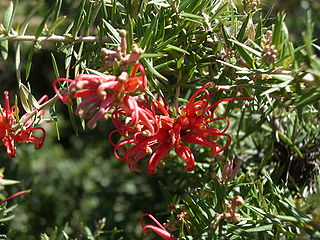
Grevillea juniperina, commonly known as juniper- or juniper-leaf grevillea or prickly spider-flower, is a plant of the family Proteaceae native to eastern New South Wales and south-eastern Queensland in Australia. Scottish botanist Robert Brown described the species in 1810, and seven subspecies are recognised. One subspecies, G. j. juniperina, is restricted to Western Sydney and environs and is threatened by loss of habitat and housing development.
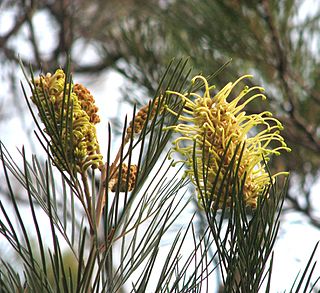
Grevillea whiteana, also known as Mundubbera grevillea, is an erect shrub or tree which is endemic to Queensland.
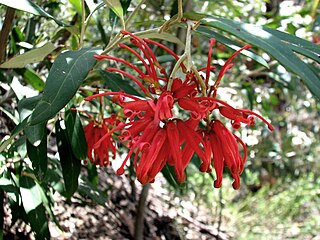
Grevillea victoriae, also known as royal grevillea or mountain grevillea, is a shrub which is endemic to south-eastern New South Wales and mountainous parts of Victoria in Australia.
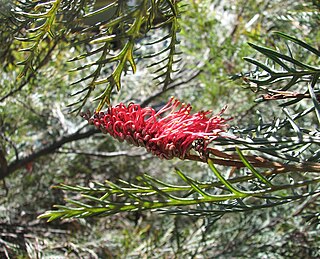
Grevillea 'Red Hooks' is a grevillea cultivar from Australia. It is a shrub that grows to 3 metres in height and 4 to 5 metres in width and has pinnate leaves with narrow-linear lobes. The inflorescences comprise greyish-green perianths and red styles which bend backwards. After being grown for many years under the misnomers Grevillea hookeriana or Grevillea hookerana, the cultivar was registered in 1987 under the name 'Red Hooks'. It is thought to be a hybrid of G. longifolia x G. tetragonoloba.
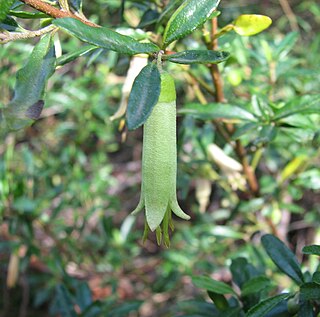
Correa glabra, commonly known as the rock correa, is a species of tall, erect shrub that is endemic to Australia. It usually has elliptical, mostly glabrous leaves and pendent, pale green to pale yellow flowers arranged singly on short side shoots.
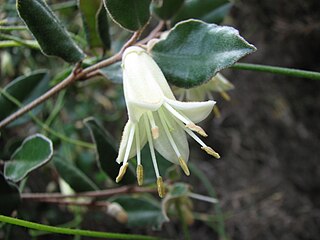
Correa backhouseana is a species of rounded shrub that is endemic to coastal and near-coastal areas of southern Australia. It has elliptical to egg-shaped or round leaves that are densely hairy on the lower surface, and cylindrical to funnel-shaped, cream-coloured to pale green or red and yellow flowers.

Correa pulchella, commonly known as the salmon correa, is a species of small prostrate to erect shrub that is endemic to South Australia. It has glabrous, leathery, narrow oblong to broadly egg-shaped leaves and pendulous, cylindrical, pink to red or orange flowers arranged singly on short side branches.

Telopea oreades, commonly known as the Gippsland-, mountain- or Victorian waratah, is a large shrub or small tree in the family Proteaceae. Native to southeastern Australia, it is found in wet sclerophyll forest and rainforest on rich acidic soils high in organic matter. No subspecies are recognised, though a northern isolated population hybridises extensively with the Braidwood waratah (T. mongaensis). Reaching a height of up to 19 metres, T. oreades grows with a single trunk and erect habit. It has dark green leaves with prominent veins that are 11–28 centimetres (4.3–11 in) long and 1.5–6 cm (0.6–2.4 in) wide. The red flower heads, known as inflorescences, appear in late spring. Each is composed of up to 60 individual flowers.

Callistemon 'Splendens' is a commonly grown cultivar of the plant genus Callistemon. It has a compact and rounded habit and usually grows to about 2 metres high and wide, although it may grow taller. Large, well-displayed "brushes" are produced in late spring, with further flowering sometimes occurring at other times. New growth is pink-tinged and the leaves are elliptic and up to 90 mm long and 20 mm wide.
Grevillea pteridifolia is a species of Grevillea native to Australia. Common names include silky grevillea, Darwin silky oak, ferny-leaved silky oak, fern-leaved grevillea, golden grevillea, golden tree and golden parrot tree. It occurs in Western Australia, Northern Territory, and Queensland.
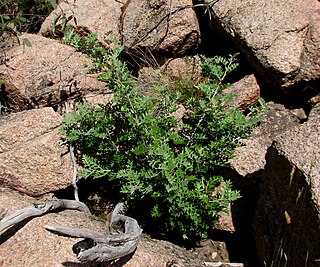
Grevillea willisii is a shrub species which is endemic to the eastern highlands of Victoria, in Australia. Common names include Omeo Grevillea and Rock Grevillea.
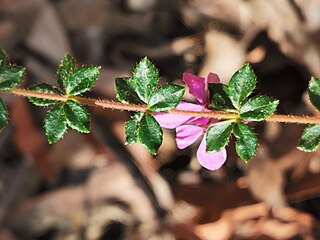
Tetratheca thymifolia, commonly known as black-eyed Susan or thyme pink-bells, is a small shrub in the family Elaeocarpaceae found in southeastern Australia.

Kunzea 'Badja Carpet' is a cultivar of Kunzea badjaensis. It is a low-growing shrub of the family Myrtaceae found in the southeastern tablelands of New South Wales, Australia. It is similar to Kunzea capitata, but it has a lower growth form and white rather than pink flowers. Because of these differences it has been described as a distinct species. The species had previously been known as Kunzea sp. 'Wadbilliga'.
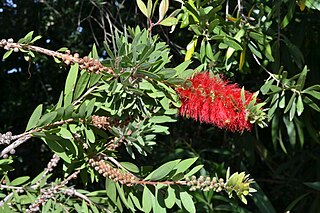
Melaleuca citrina, commonly known as common red, crimson or lemon bottlebrush, is a plant in the myrtle family, Myrtaceae and is endemic to New South Wales and Victoria in Australia. It is a hardy and adaptable species, common in its natural habitat. It is widely cultivated, not only in Australia, often as a species of Callistemon. It was one of the first Australian plants to be grown outside the country, having been taken to England in 1770 by Joseph Banks. Its showy red flower spikes, present over most of the year in an ideal situation, account for its popularity.
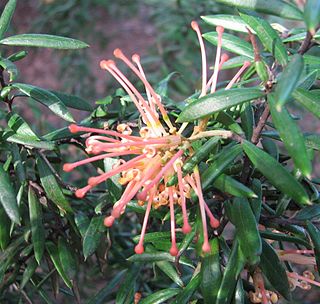
Grevillea 'Poorinda Queen' is a grevillea cultivar that originates from Australia.
References
- 1 2 3 4 5 6 "Correa 'Dusky Bells'". Descriptions of Registered Cultivars. Australian Cultivar Registration Authority. Retrieved 22 September 2009.
- ↑ "RHS Plant Selector - Correa 'Dusky Bells'" . Retrieved 15 April 2020.